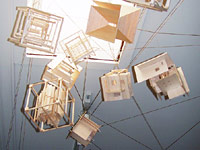|
|||||||||||||||||||||||||||||||||||||||||
| Architectural Technologies 2 - ARCH1172 | |||||||||||||||||||||||||||||||||||||||||

Description Environment: Thermal comfort and building climatology: perception and comfort; the body's responses; bioclimatic classification and traditional buildings. Solar geometry and control of sunlight. The building envelope: thermal performance; principles of heat transfer; solar radiation effects; absorptivity, reflectivity, conduction, thermal gradients; condensation and thermal insulation; degree day concept and prediction of heating requirements. Structures: Analysis of structural precedents in relation to human need and design practice. Outline of key structural behaviour concepts: loading - including load transfer, forces at supports and connections; resistance to loads - including stability, strength and stiffness; stress - including axial, shear, bending and deformation. Focus on basic linear structural elements and systems - including cable and arch, strut and column, beam, truss, frame. Concept and techniques of modelling, predicting and incorporating structural behaviour in design. Basic structural modelling techniques and problem solving tools - physical, graphical, numerical, computer-assisted. Introduction to basic statics, properties and strength of materials. Introduction to basic building physics. Implications for structural, constructional and environmental issues in design. Construction: Introduction to masonry and timber in design and construction with an emphasis on small to medium scale buildings. The basic physical properties, manufacturing processes, use and performance of masonry and timber. An introduction to construction documentation standards. Lecture material will be supported through associated projects in the Design Workshop program.
|
|||||||||||||||||||||||||||||||||||||||||


